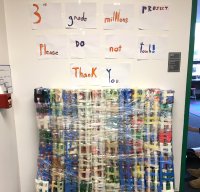What Does a Million Look Like?
An effort to help third graders visualize large numbers turns into an ambitious project to build a model of a million.
Your content has been saved!
Go to My Saved Content.The United States is known for its culture of achievement around math. In Mathematical Mindsets, Jo Boaler discusses the toxicity of this achievement culture, which she says disincentivizes teachers from using open-ended tasks that allow for multiple pathways to plausible solutions—instead they opt for more reliable means for approaching math, usually in the form of workbooks and worksheets.
In reality, though, math is a literacy, and it’s important that it be treated as such. It’s reductive to teach it only through simple call-and-response questions. Math requires curiosity, inquiry, and, most importantly, play.
In an effort to move away from the current achievement culture and toward a way of teaching math that builds conceptual understanding, my team and I decided to embark on an ambitious math project: to build a scale model of a million.
We came to this after one of our initial lessons on place value. The children seemed to understand how to visualize two- and three-digit numbers with precision. They could do so because they had the tools necessary—base 10 blocks. But when it came time to visualize what 10,000, 100,000, and 1 million looked like, they were coming up short.
Helping Kids Visualize Large Numbers
Later that day, I noticed a thousand block on my guided reading table. Next to it sat a handful of aluminum LaCroix cans. I had just hosted a team meeting in my room, and so naturally there were some sparkling water cans left over. I noticed that four cans happened to be about the same size as the thousand block.
I imagined what it might be like to collect enough cans to make enough thousand-size blocks to make a model of a million. I feverishly sent an email to my team, asking if they thought this crazy idea was worth pursuing, and they were all in.
That day the million model was born.
We got to work right away. The weeks turned into months, and children brought in what ended up being over 4,000 aluminum cans from home. Note: If you decide to do this project, make sure to wash out all the cans—very important if you want to avoid collecting ants along with the cans.
Four cans at a time, we built thousand after thousand, which turned into ten thousand after ten thousand, hundred thousand after hundred thousand, and before we knew it, three months had passed and we were finally ready to assemble our model of a million.
Our school embraces the Singapore style of mathematics instruction, which entails using math tasks to build conceptual understanding of math skills. Luckily for us, this project offered ample opportunities for the creation of math tasks related directly to the project. They seemed to sprout serendipitously, immediately engaging students due to their investment in the project. Here are a few of the questions we came up with:
- If it takes four cans to make a thousand, how many will we need to make 10,000? 100,000? 1 million?
- How many thousands are in a million?
- Our million model currently has _____ cans. How many more do we need?
It’s important to remember that this wasn’t only fun and games—it was directly related to our unit on place value, specifically to standards around identifying, reading, and writing numbers to the ten-thousands place. Our stretch goal was to have kids identifying, reading, and writing numbers to the millions place. By the end of the project, almost every child in our grade was able to achieve this stretch goal, showcasing the inherent academic value in engaging children in projects related to math.
Sharing the Learning
In the early spring, almost six months after the project had begun, it was our grade’s turn to host the school assembly. It was the first time our school held a math assembly, and we were all so thrilled that this milestone would be our chance to share our million model.
We shared the background of the project and what we’d learned, and we read the book How Much Is a Million? by David M. Schwartz. The assembly ended with the entire third grade counting as we assembled the model in front of the school.
“Nine-hundred ninety thousand...” the children shouted suspensefully just before adding the final ten-thousand block to the model. “One million!” The assembly erupted in applause.
Later that day, a first grader approached me in the hallway.
“Mr. France?” he said, his chestnut eyes smiling at me.
“Hey buddy! What’s up?” I replied.
“I hope we get to do the million model when I get to third grade,” he said excitedly. This was an unexpected outcome. The project was fun, of course, and it’s hard to dispute the academic value. But our project not only engaged the third graders who did it—it sparked excitement about math throughout the whole school.
